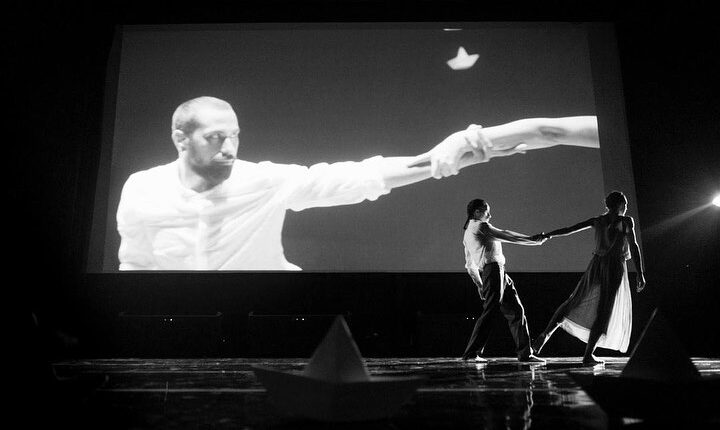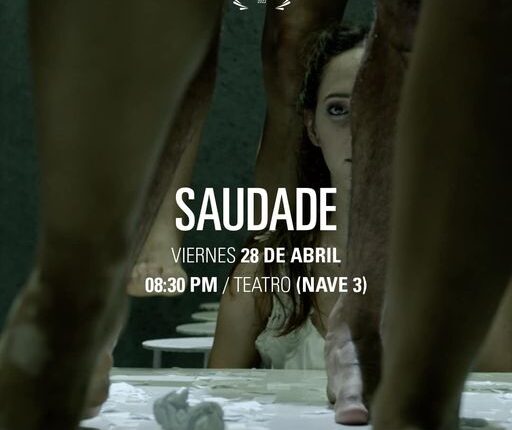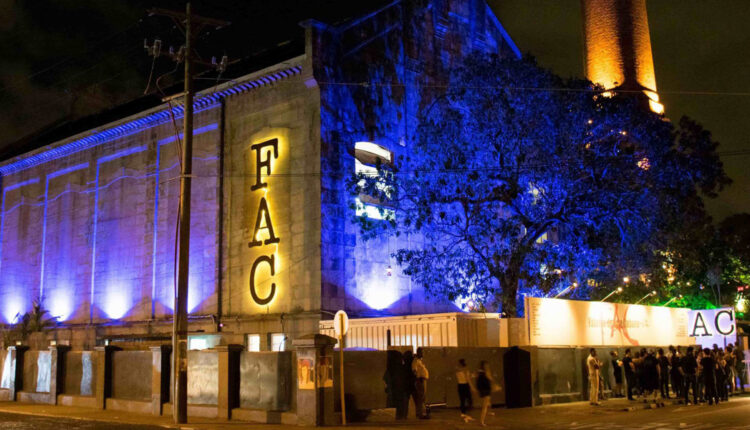Estreno mundial de Saudade en La Habana y en Denver (+English)
LA HABANA – Saudade, ha escrito el teatrólogo y escritor cubano Norge Espinosa, “es un ciclo infinito bajo el agua”; “es cruzar un mar imaginario, a contracorriente”; es “una pequeña revelación sobre la nostalgia, la distancia, lo que ya no está”. Cada quien lo vive y lo expresa en diferentes maneras; en algunos casos, la saudade también se transforma en trabajo de equipo, en arte, en belleza.
A partir de una “provocación” realizada por la embajada portuguesa en 2019 para la presentación de proyectos que conectaran las culturas portuguesa y cubana, surge la pieza transdisciplinaria “Saudade”, estrenada, al fin, el pasado viernes 28 de abril en su sede conceptual, Fábrica de Arte Cubano.
Para el equipo de especialistas en diversas manifestaciones artísticas que atesora este singular espacio en La Habana, el proceso creativo terminó dando giros sorpresivos, con todo lo que implica el paso de una pandemia durante casi dos años en Cuba y las restricciones de movilidad y cercanía física vividas.

Buscaron, explicó Sandra Ramy, una de las cuatro directoras de la obra junto a Sandra Lopes, X Alfonso e Inti Herrera, lo que conecta a ambas culturas en lugar de lo que resulta ajeno. Esto fue: la relación de los portugueses con el mar y el sentimiento de saudade, unida al vínculo tan arraigado de los cubanos como isleños con el mismo elemento.
Para Herrera, a cargo del equipo cinematográfico, uno de los principales retos fue iniciarse en “un trabajo y una concepción que ya venía realizando magistralmente la coreógrafa Sandra Ramy, con una visualidad y una puesta totalmente pensada para teatro”. Una de las grandes reinvenciones y muestras de resiliencia del equipo estuvo precisamente en llevar Saudade a un formato audiovisual.
“Hay varios elementos que confluyen para llegar a este resultado: el lujo de tener coreografía y bailarines a disposición de la puesta en cámara. Esto quiere decir que repetimos movimientos y cortamos y volvimos a empezar muchas veces, tantas como hizo falta. No es lo mismo caerle atrás a un bailarín que danza, que tener a estos artistas trabajando para una cámara. Es algo que aumenta las posibilidades expresivas”, explicó.
Y enfatiza: “Tuvimos un grupo de bailarines tan bien preparados, tan tocados por la varita mágica, tan perfectos y hermosos, que siempre pensé que la cámara tenía que estar pegada a ellos”.
El proceso de creación musical no estuvo carente de asombros. Pepe Gavilondo, a cargo de la banda sonora original, se sumergió junto a su equipo en el estudio del Fado, Patrimonio Inmaterial de la Humanidad de acuerdo con la UNESCO, de los Cantos Campesinos y otras sonoridades cubanas, que resultaron referencias esenciales en el tratamiento del espectáculo. Desde una mirada novedosa se compuso un arreglo para música coral mezclada con la música contemporánea.
“No había tenido que crear música como esa –refiere Gavilondo–. Pero una vez que el material audiovisual estuvo listo, teniendo sus colores, su ritmo, su coreografía y la manera en que se filmó, todo fue más sencillo porque nos resultaba muy inspirador. Descubrir el vínculo melódico fue muy hermoso; probar esa cercanía entre dos culturas tan distantes geográficamente”.
La obra se cuestiona en poco más de 30 minutos de excelencia en el tratamiento de cada detalle ¿qué queda registrado en la tierra de aquel que parte al mar? ¿Qué queda en el que parte de aquello que deja en tierra? ¿Qué es Saudade? La relación tan íntima que mantiene la cultura portuguesa y la cubana con el mar ha sido el vínculo. Ese mar, que tantos otros seres humanos en el mundo ni siquiera han visto jamás, nos ha puesto a mirarnos. Para cualquiera que ha salido de su tierra, con la incertidumbre de lo desconocido en sus espaldas, es sencillo comprender Saudade, esa relación con lo lejano, lo inalcanzable y con la tierra, que nos devuelve a un espacio de comprensión humana.
Desde una idiosincrasia y geografía diferente como lo es la cubana, el intento por comprender, aspirar y manifestar Saudade está signado por el contraste.
“Todos los que estuvimos involucrados estábamos usando este proceso como forma para respirar en medio de una pandemia”, recuerda Sandra Ramy sobre los tiempos pandémicos, donde precisamente respirar se hacía peligroso. “Muchas de las personas del equipo ahora ya no viven en Cuba, algo que también se aborda en este trabajo: la partida”, agrega. Un proceso interno de saudade durante la creación de una pieza que no estuvo exenta del contexto migratorio nacional, del éxodo humano.
Saudade devino entonces un espectáculo también transnacional, no solo porque ha estado latiendo desde diversas geografías, de la mano de quienes trabajaron para su realización, sino también porque fue un estreno simultáneo entre La Habana y Denver (Estados Unidos). De la mano de Sandra Lopes y X Alfonso, la obra se presentó también en el evento Fábrica de Arte Américas, celebrado entre el 26 y 28 de abril pasado.
En la actualidad, el equipo de directores pretende regresar a la idea original de hacerlo como una puesta en escena, en la cual cambiaría el lenguaje de forma radical. “Eso ha sido también un proceso maravilloso, el traslado de esta creación, con un equipo distinto, y mantener ese espíritu en el lenguaje de nuevos bailarines que están adueñándose de ese mensaje y colocándose en él –añade Sandra Ramy–. Es una forma en que esta obra pueda nacer una vez más”.
Progreso Semanal/ Weekly autoriza la reproducción total o parcial de los artículos de nuestros periodistas siempre y cuando se identifique la fuente original y el autor.
Síganos en Facebook, en Twitter @ProgresoHabana y en Telegram.
Fotos: Eduardo Reyes Aranzaez
*****
English version:
World premiere of Saudade in Havana and Denver
Saudade, writes the Cuban playwright and writer Norge Espinosa, “is an infinite cycle under water”; “It is crossing an imaginary sea, against the current”; it is “a small revelation about nostalgia, distance, what is no longer there.” Each one lives it and expresses it in different ways; in some cases, Saudade is also transformed into teamwork, into art, into beauty.
From a “provocation” carried out by the Portuguese embassy in 2019 for the presentation of projects that connect the Portuguese and Cuban cultures, the transdisciplinary piece “Saudade” emerged, and finally premiered last Friday, April 28, at its conceptual headquarters , Fábrica de Arte Cubano (FAC).
For the team of specialists in various artistic manifestations that this unique space in Havana treasures, the creative process ended up taking surprising turns, with all that the passage of a pandemic implies for almost two years in Cuba and the restrictions on mobility and physical proximity lived.

They searched, explained Sandra Ramy, one of the four directors of the work along with Sandra Lopes, X Alfonso and Inti Herrera, what connects both cultures instead of what is alien. This was: the relationship of the Portuguese with the sea and the feeling of saudade, together with the deep-rooted bond of Cubans as islanders with the same element.
For Herrera, in charge of the cinematographic team, one of the main challenges was to begin “a work and a conception that the choreographer Sandra Ramy had already masterfully carried out, with a visuality and a staging totally designed for theatre.” One of the team’s great reinventions and shows of resilience was precisely in bringing Saudade to an audiovisual format.
“There are several elements that come together to reach this result: the luxury of having choreography and dancers available for the camera. This means that we repeat movements and cut and start again many times, as many as it took. It is not the same to fall behind a dancer who dances, than to have these artists working for a camera. It is something that increases the expressive possibilities,” she explained.
And she emphasizes: “We had a group of dancers so well prepared, so touched by the magic wand, so perfect and beautiful, that I always thought the camera had to be glued to them.”
The musical creation process was not without surprises. Pepe Gavilondo, in charge of the original soundtrack, immersed himself with his team in the study of Fado, Intangible Heritage of Humanity according to UNESCO, of the Cantos Campesinos and other Cuban sounds, which turned out to be essential references in the treatment of the Show. From a novel look, an arrangement for choral music mixed with contemporary music was composed.
“I hadn’t had to create music like that,” says Gavilondo. But once the audiovisual material was ready, having its colors, its rhythm, its choreography and the way it was filmed, everything was easier because we found it very inspiring. Discovering the melodic link was very beautiful; prove that closeness between two cultures so distant geographically.”
The work is questioned in little more than 30 minutes of excellence in the treatment of every detail, what is recorded on the land of the one who leaves for the sea? What remains in the part of what it leaves on land? What is Saudade? The intimate relationship that Portuguese and Cuban culture maintains with the sea has been the link. That sea, which so many other human beings in the world have never even seen, has made us look at ourselves. For anyone who has left their land, with the uncertainty of the unknown behind them, it is easy to understand Saudade, that relationship with the distant, the unattainable and with the earth, which returns us to a space of human understanding.
From a different idiosyncrasy and geography such as the Cuban one, the attempt to understand, aspire and manifest Saudade is marked by contrast.
“All of us who were involved were using this process as a way to breathe in the middle of a pandemic,” recalls Sandra Ramy about pandemic times, when precisely breathing became dangerous. “Many of the people on the team now no longer live in Cuba, something that is also addressed in this work: departure,” she adds. An internal process of saudade during the creation of a piece that was not exempt from the national migratory context, from the human exodus.
Saudade then also became a transnational show, not only because it has been beating from different geographies, hand in hand with those who worked for its realization, but also because it was a simultaneous premiere between Havana and Denver (United States). Hand in hand with Sandra Lopes and X Alfonso, the work was also presented at the Fábrica de Arte Américas event, held between April 26 and 28.
Currently, the team of directors intends to return to the original idea of doing it as a staging, in which the language would radically change. “That has also been a wonderful process, the transfer of this creation, with a different team, and maintaining that spirit in the language of new dancers who are taking ownership of that message and placing themselves in it,” adds Sandra Ramy. “It is a way in which this work can be born once again.”





